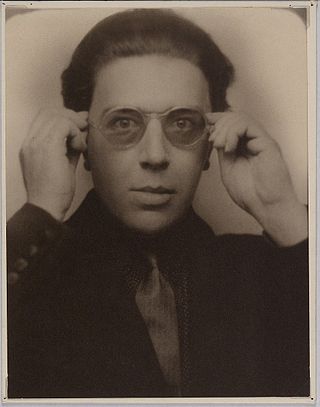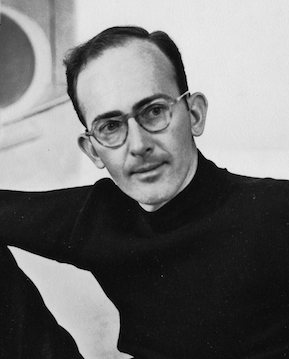
André Robert Breton was a French writer and poet, the co-founder, leader, and principal theorist of surrealism. His writings include the first Surrealist Manifesto of 1924, in which he defined surrealism as "pure psychic automatism".
Rigaud Benoit (1911–1986) had become one of the three or four most highly prized Haitian artists well before his death.
The Washington Color School, also known as the Washington, D.C., Color School, was an art movement starting during the 1950s–1970s in Washington, D.C., in the United States, built of abstract expressionist artists. The movement emerged during a time when society, the arts, and people were changing quickly. The founders of this movement are Morris Louis and Kenneth Noland, however four more artists were part of the initial art exhibition in 1965.
Stevenson Magloire was a painter born in Pétion-Ville, Haiti. He is the son of artist Louisiane Saint Fleurant, a founder of the School of Soleil art movement. Magloire's paintings are bold and expressionistic, frequently incorporating people, birds, and Vodou and Christian symbolism.

Robert Seldon Duncanson was a 19th-century American landscapist of European and African ancestry. Inspired by famous American landscape artists like Thomas Cole, Duncanson created renowned landscape paintings and is considered a second generation Hudson River School artist. Duncanson spent the majority of his career in Cincinnati, Ohio and helped develop the Ohio River Valley landscape tradition. As a free black man in antebellum America, Duncanson engaged the abolitionist community in America and England to support and promote his work. Duncanson is considered the first African-American artist to be internationally known. He operated in the cultural circles of Cincinnati, Detroit, Montreal, and London. The primary art historical debate centered on Duncanson concerns the role that contemporary racial issues played in his work. Some art historians, like Joseph D. Ketner, believe that Duncanson used racial metaphors in his artwork, while others, like Margaret Rose Vendryes, discourage viewers from approaching his art with a racialized perspective.

Prospère Pierre-Louis (1947–1997), also known as Prosper Pierre-Louis, was a Haitian artist, painter; and one of the main contributors to the Saint Soleil art movement. His paintings depicting mystical Vodou lwa and spirits are especially noteworthy.
Jacques-Enguerrand Gourgue was one of Haiti's most renowned painters of the 20th century.
Jean-Claude "Tiga" Garoute was a Haitian painter and sculptor. Born in Jérémie, Garoute co-founded a museum of ceramic art in Haiti named Poto-Mitan. An abstract painter, he participated in art festivals throughout the world.

Hector Hyppolite was a Haitian painter. Considered as the "Grand Maître of Haitian Art" Born in Saint-Marc, Hyppolite was a third generation Vodou priest, or oungan. He also made shoes and painted houses before taking up fine art painting, which he did untrained. Hyppolite spent five years outside of Haiti from 1915 to 1920. His travels abroad included trips to New York and Cuba. Although he later claimed those years had been spent in Africa, such as Dahomey and Ethiopia, scholars regard that as more likely an instance of promotional myth-making than factual.
Haitian art is a complex tradition, reflecting African roots with strong Indigenous, American and European aesthetic and religious influences. It is an important expression of Haitian culture and history.

Louisiane Saint Fleurant was a Haitian female artist and painter. She was a founder of the peasant Saint Soleil art movement.
Cary Selden Rodman was a prolific American writer of poetry, plays and prose, political commentary, art criticism, Latin American and Caribbean history, biography and travel writing—publishing a book almost every year of his adult life, he also co-edited Common Sense magazine.

Haitian Vodou art is art related to the Haitian Vodou religion. This religion has its roots in West African traditional religions brought to Haiti by slaves, but has assimilated elements from Europe and the Americas and continues to evolve. The most distinctive Vodou art form is the drapo Vodou, an embroidered flag often decorated with sequins or beads, but the term covers a wide range of visual art forms including paintings, embroidered clothing, clay or wooden figures, musical instruments and assemblages. Since the 1950s there has been growing demand for Vodou art by tourists and collectors.
Karl Joseph Maria Drerup was a leading figure in the mid-twentieth-century American enamels field. Trained as a painter, Drerup taught himself to enamel in the early 1940s, fusing glass to metal through a high-temperature firing process. Through his inventive, "painterly" approach to the medium, he advanced enameling to new levels of beauty, power, and expressiveness. Drerup's love of nature is apparent in every detail of his intimate woodland scenes, just as his depictions of humble workers in natural settings reveal his profound respect for humanity. A modest, self-deprecating individual, he exerted an enormous impact on the generation of enamel artists that emerged in the United States in the period immediately following World War II.

Winslow George Anderson was an American artist, painter, ceramicist and glass designer from Plymouth, Massachusetts. A graduate of Alfred University's School of Ceramics, Anderson was a leading glass designer for the Blenko Glass Company of West Virginia (1946-1953) and design director for Lenox China and Crystal, located in Trenton, New Jersey (1953-1979). He was the recipient of numerous accolades during his lifetime, including Museum of Modern Art Good Design Awards. His works have been exhibited and collected by museums across the United States, including the Baltimore Museum of Art, Cooper Hewitt, Smithsonian Design Museum, Metropolitan Museum of Art, Museum of Modern Art, and the Solomon R. Guggenheim Museum.
Gerard Valcin (1923-1988) was a self taught, Haitian painter who is known most commonly for his work depicting Haitian Vodou rituals and the labors of everyday Haitian life.
Jean-Marie Obin is a Haitian artist. She is from a family of painters and is the daughter of the painter Philomé Obin.
Paul Claude Gardère was a Haitian-born, Brooklyn-based visual artist whose work explored "post-colonial history, cultural hybridization, race, and identity, in and beyond the Haitian diaspora." Gardère's work has been widely exhibited throughout the United States, including at institutions such as the Studio Museum in Harlem, the Figge Art Museum, Lehigh University, Pomona College Museum of Art, and the Jersey City Museum, and is included in a number of prominent institutional collections, including that of Thea Museum of Modern Art in New York, the Studio Museum in Harlem, the Brooklyn Museum, the New Orleans Museum of Art, Schomburg Center for Research in Black Culture, The Milwaukee Art Museum, the Figge Art Museum, the Columbus Museum, the Beinecke Library at Yale University and the Herbert F. Johnson Museum of Art at Cornell University.
Luce Turnier was a Haitian painter and collage artist. One of Haiti's leading artists, Turnier achieved international renown for her fusion of Haitian culture and modernist style.








